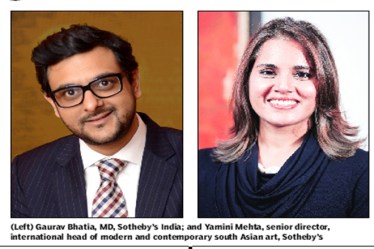The global market for Indian art has never been so vibrant. There’s huge interest, not only in the auctions held in the country, but also in the many major fairs and exhibitions dedicated to artworks from the region. Realising its importance, several prominent art houses are now renewing their activities in India.
Christie’s, the over 250-year-old London institution, held its inaugural auction in India only in 2013, and followed it up with three runs—in 2014, 2015 and 2016—setting new records in sales and indicating their continuing success in India. In 2015, Saffronart, a premier auctioneer with deep Indian roots, appointed Hugo Weihe, a former international director of Asian art at Christie’s, as its new CEO.
Now, legendary auction house Sotheby’s is at an exciting stage in India and on an expansion mode. After the opening of its office at the Taj Mahal Palace in Mumbai late last year, the auctioneer plans to further develop its calendar of events and activities in the country. “With the vibrant art scene in India, we are engaging with more people in India than ever before, particularly through our expanded calendar of events, ranging from exhibitions, talks and educational programmes,” says Gaurav Bhatia, MD, Sotheby’s India.
Bhatia, a prominent luxury marketer who played a key role at European luxury goods conglomerate LVMH for over a decade, joined Sotheby’s India only a couple of months ago.
One of the many initiatives on the anvil is bringing its Institute of Art to New Delhi on February 24-25 and offering two highly immersive courses on international contemporary art with a focus on south Asia. “Education is a key priority for India. We need to democratise the conversation around art and inspire new collectors,” explains Bhatia.
Sotheby’s is also working with leading collectors in the country with regular events in New Delhi and Mumbai. “Also in Q1, we plan on bringing a preview of our New York Asia Week sale to New Delhi and have a gamut of activities around some very exciting, unseen works of south Asian modern and contemporary art,” says Bhatia.
As per Bhatia, Indian art is seeing a slower but more sustainable regrowth. “With a stronger base and focus on cultural value (rather than purely fiscal), Indian art is seeing resurgence. There is a realistic optimism and excitement in the market. The Kochi-Muziris Biennale, the Indian Art Fair, private museums and initiatives have created a wonderful ecosystem and are adding a wonderful flavour, shaping the collector’s mind and giving them incredible exposure,” he says.
You may also like to watch this video
The future is bright for the current and future market for contemporary Indian art on the international market, adds Yamini Mehta, senior director, international head of modern and contemporary south Asian art, Sotheby’s. “I am here at the art fair hoping to scope out new talent and see who might be added to our auctions in time to come. It is a chance for us to meet galleries and artists from across India to give us a sense of the art scene,” she adds.
